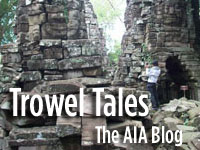The Latest from Istanbul
by Mark Rose
September 3, 2009
 One of the most exciting projects this year was the survey of a huge archaeological site in Istanbul. The work is headed up by Sengul Aydingun (Kocaeli University), but involves researchers from various Turkish and international universities. They were documenting remains on and around a peninsula that juts out into the Küçükçekmece lagoon, now linked to the Sea of Marmara by a narrow channel but more open to it in the past. It’s a striking location, which I had the pleasure of touring not long ago.
One of the most exciting projects this year was the survey of a huge archaeological site in Istanbul. The work is headed up by Sengul Aydingun (Kocaeli University), but involves researchers from various Turkish and international universities. They were documenting remains on and around a peninsula that juts out into the Küçükçekmece lagoon, now linked to the Sea of Marmara by a narrow channel but more open to it in the past. It’s a striking location, which I had the pleasure of touring not long ago.
So what did they find? The entire peninsula seems to be one giant site, so we are talking at a minimum of 8 km2. Actually, it is larger, since there are remains on the shore east of the peninsula as well as submerged in the lagoon. The classical period remains include two harbor installations and seawalls that extend for kilometers. The larger harbor may date to about the 4th century B.C., and may have the foundations of a lighthouse, an indication that it was an important port. And there are later remains as well, such as Hellenistic pottery and a Corinthian column capital placed in the 2nd century B.C. There is later material as well, such as an inscribed grave marker of the 4th century A.D., not to mention a Roman roadway that the excavators have suggested is part of the imperial Via Egnatia. And across the site there are indications, such as columns, of public or commercial buildings. They excavators have identified a necropolis and located tentatively likely residential areas, plus architectural remains to the east, which may represent villas.
These classical remains alone are worthy of a large-scale investigation, but there is more. At one locality on the peninsula, designated Küçükçekmece A6, there is a wide scatter of flint cobbles and tools. The artifacts look similar to those from the central Anatolian late Pre-Pottery Neolithic B, which began around 9500 B.C. If they prove to be from that culture, this site at Küçükçekmece could be one of Europe’s earliest farming communities. That’s very exciting.
When you consider the setting, these finds are all the more remarkable. Küçükçekmece is just 20 km from downtown Istanbul, which is Europe’s largest city and is growing very rapidly. How has this rich archaeological landscape escaped both being developed before now and being recognized as so important? The land is currently farmed, so perhaps it was just a case of being hidden in plain sight. It is a rare discovery, and we can only hope that the archaeologists are granted the time and resources to study and protect it. That the Monuments and Museums Department of the Culture and Tourism Ministry has granted an excavation permit is a welcome step. Perhaps consideration should be given to converting the entire area into an archaeological park. That would be a great precedent.
Comments posted here do not represent the views or policies of the Archaeological Institute of America.






 Heather Pringle is a freelance science journalist who has been writing about archaeology for more than 20 years. She is the author of Master Plan: Himmler's Scholars and the Holocaust and The Mummy Congress: Science, Obsession, and the Everlasting Dead. For more about Heather, see our
Heather Pringle is a freelance science journalist who has been writing about archaeology for more than 20 years. She is the author of Master Plan: Himmler's Scholars and the Holocaust and The Mummy Congress: Science, Obsession, and the Everlasting Dead. For more about Heather, see our 



